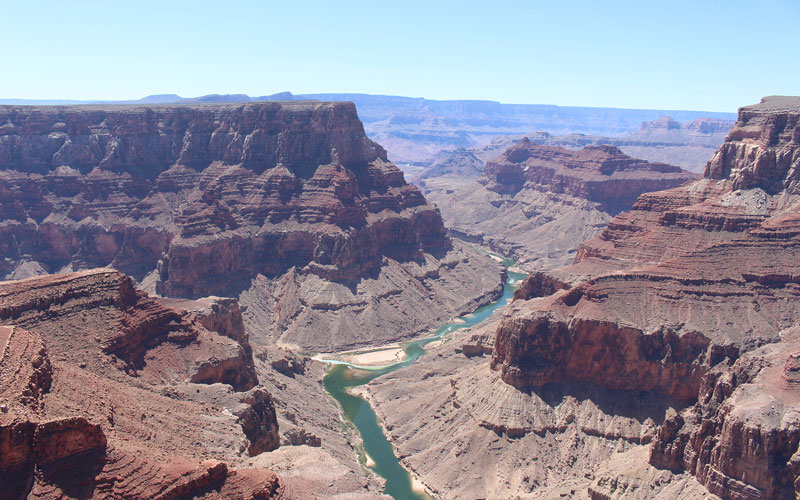
A new report raises concerns about how much water will be needed to replenish groundwater basins in central Arizona. It comes at a time of dire shortages on the Colorado River, which supplies most of the state’s surface water. (Photo by Sophia Kunthara/Cronkite News)
PHOENIX — A key water management tool that sustains housing development in central Arizona does not have a rosy future, according to a new report from Arizona State University.
The report looks at the Central Arizona Groundwater Replenishment District, which the Legislature established in 1993 to assure the replenishment of groundwater that’s tapped for development.
Developers and, by extension, home buyers, can pump and purchase groundwater and then pay into the program; the district then has to replenish the water that serves those homes. This is a way to meet the state’s water management goals and comply with the legally required 100-year water supply.
But the report outlines several concerns about the specific rules that govern the replenishment district and casts doubt on the district’s ability to find water to meet expected obligations.
One concern is that the replenished water does not have to be returned to the same place where it originally was pumped. The district only has to put water back into the larger active management area, and the recharged water doesn’t necessarily migrate to where it’s needed.
“It’s an unsustainable practice,” said Kathy Ferris with ASU’s Kyl Center for Water Policy, the report’s co-author. “There are so many different aquifers and layers. There are seven subbasins. And water doesn’t just move around like it’s in a bathtub. Sometimes it doesn’t move at all, depending on where it’s recharged.”
There are five active management areas in central Arizona. The one in Phoenix, for example, covers 5,646 square miles.
Another concern is financial. As water in Arizona becomes more expensive, some homeowners enrolled in the replenishment district have looked for water that’s cheaper than the original source the developer identified for its required 100-year water supply. A different source may free homeowners from paying an annual charge for replenishment.
The problem, the report said, is that the district still must find and pay for water “to meet the member’s long-term replenishment obligation.”
Depending on how many homeowners use this cheaper-source strategy, it could mean consistent expenses but lower revenues for the replenishment district, which has fixed costs that do not fluctuate depending on how much water needs to be replenished that year.
Ferris cited a consultant’s report from 2017 that said if all of the Phoenix area lands enrolled in the replenishment district used this workaround, the result would be “financially catastrophic.” The consultant’s policy recommendations involved legal or regulatory changes that have not been enacted.
The ASU report also raises concerns over the amount of water the replenishment district is expected to need to meet its current and projected obligations, especially at a time of shortage conditions on the Colorado River, the state’s largest source of surface water.
The district’s board also runs the Central Arizona Project canal system. In a statement, the agency pointed out it “was charged with the statutory obligation to manage the CAGRD since its inception more than 25 years ago,” saying it “has fulfilled this duty effectively, demonstrating fiscal responsibility while securing a robust water supply portfolio that will be available through the mid-2030s.”
CAP also acknowledged in the statement that its part of the discussion over where growth will happen in urban areas especially Maricopa County.
“CAP welcomes the opportunity to be part of it, but given that the focus of this conversation would be beyond CAP’s CAGRD responsibilities, CAP may not be the appropriate entity to convene and lead this conversation.”
The agency does not have the legal authority to reject new enrollees in the groundwater replenishment program. The Arizona Department of Water Resources does have some oversight because it approves a 10-year plan for the district and can later reverse an approval.
But the report said “such a decision will be politically difficult, will not stop the sale of previously enrolled but unconstructed lots, and will not address CAGRD’s continuing replenishment obligations for its current members.” It recommends authorizing the program to deny accepting new members if needed.
A spokeswoman at the water resources department declined to comment on the ASU report, saying it had not yet been reviewed.
The report comes on the heels of the state releasing its own water bombshell: a new model for the Pinal Active Management Area that shows an expected shortfall of more than 8 million acre-feet of water. An acre-foot is enough water to cover 1 acre of land with 1 foot of water, enough to supply a family of four for a year.
“I think that the Pinal situation demonstrates that as time has gone on, we’ve learned more and more about our groundwater resources,” Ferris said. “And our scientific ways of assessing how much groundwater is there have dramatically changed. Nobody’s talking about the fact that, well, even if there was enough groundwater, if it’s all used up, it gets all used up.
“Then what?”
